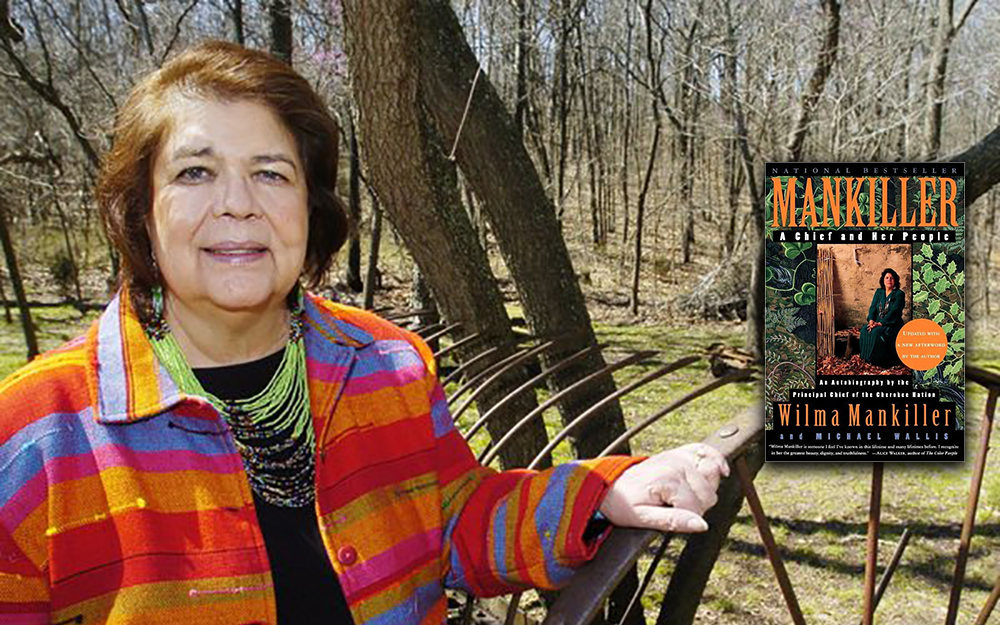
Honorable Leader and Wise Chief
By Heidi Simmons
—–
“Mankiller: A Chief and Her People”
By Wilma Mankiller with Michael Wallis — Memoir
—–
More than ever, we need to be inspired. Great acts of selflessness, compassion, and moral fortitude are rare these days. It is a challenge to find real-life heroes, living or dead.
“ManKiller: A Chief and Her People” (St. Martin’s Griffin, 384 pages) is a personal tale of a humble woman who stepped up to make a difference.
Wilma Pearl Mankiller begins her story living a full and rich life on her family’s ancestral land near Tahlequah, Oklahoma. Half Cherokee and half white, Wilma and her 11 siblings lived without amenities like running water and electricity. They shared hand-me-downs and ran around the forest barefoot. She did not know hunger or poverty.
In the mid 1950s, the United States government relocated Indian families to large American cities. The Mankiller family moved to San Francisco where they lived in a small apartment. Wilma was only ten years old. It was there that Wilma, for the first time, experienced poverty. It was a strange world where the sounds of nature she was use to were replaced by the constant hum of a large bustling city.
Wilma shares the details of her life and growing up in Oakland, California where she got enmeshed with local community centers. As a young woman, she worked with the Black Panthers and other organizations trying to make a difference. Yet Wilma always felt like an outsider. She struggled to fit in.
In her 20’s, Wilma married an Ecuadorian man and had two daughters. Inspired by the activism of the 60s, Wilma continued her service and became involved in the Indian movement to take back Native American land that had been abandoned by the US Government. Wilma camped out at Alcatraz Island in protest.
With a renewed spirit, Wilma suddenly felt her calling. She wanted to go home and help the Cherokee people.
Wilma, now divorced and with her daughters in tow, drove back to her family’s land where they slept in her car until she could rebuild the old homestead. To restore her land, Wilma became involved with local government agencies.
As Wilma worked to restart her life in Oklahoma, she saw the needs of the Cherokee people were not being met. Wilma went to work helping others. She found innovative ways to solve problems big and small.
Eventually, Wilma would put together a project to bring water to a remote, poverty stricken area called Bell. With her own hands digging in the dirt, she inspired a community of Native Americans and whites to construct a pipeline together that would supply them with fresh water.
Wilma’s private life was complicated. She killed her best friend in a horrific auto accident. Her injuries were so severe doctors said she would never walk again. She fell in love with her best friend and associate Charlie Soap.
Through it all, Wilma was asked to run as Deputy Chief of the Cherokee Nation by Ross Swimmer the Principal Chief. And when President Ronald Regan asked Swimmer to work for him, Wilma took his place becoming the first woman Principal Chief.
The following election Wilma won with 85 percent of the vote. Wilma continued to solve problems for her community and restore Cherokee sovereignty.
This is an incredible memoir of a woman simply recounting the beats of her life and the events that shaped her as a person. She shares the story not to boast, brag or say ‘look at me and what I did’, but to bring the history of her people – ancient and current — to life.
Through her personal story, Wilma shares important moments in American history. She also brings to light the history of the Cherokee people who were among the first to have a written alphabet, an education system, a matriarchal society, and a form of operational government with US treaties. The treaties were eventually broken and the Cherokee were forced off their land onto the “Trail of Tears.”
“Mankiller” is a compelling read. It is beautifully told, descriptive and moving. There are turning points in Wilma’s life that could have gone in so many directions, but she was determined to make a difference and persevered even during the darkest hours of her life.
Within the pages of “Mankiller” you see the extraordinary woman she becomes taking shape. We get to understand who she is and how that came about. The subtext reveals those who were good and bad influences in Wilma’s life, and we see why she is moved to serve.
There is a new edition of “Mankiller” that includes her private and public life after the 1994 publication.
It is rare to see how heroes are formed and understand their drive.
I had the good fortune to know Wilma. Wise, kind and a good listener, Wilma drew out the best in people. She was strong, compassionate and refused to be bullied.
We need real-life heroes now more than ever. I can say for sure, Wilma Mankiller is a hero of mine.
If you have or haven’t read the book, the 29th Annual Palm Springs International Film Festival will show a documentary called “Mankiller” about the life and leadership of the first woman Principal Chief of the Cherokee Nation. (See CVW PSIFF True Stories: “Mankiller” page 6 for story and screenings.)












































